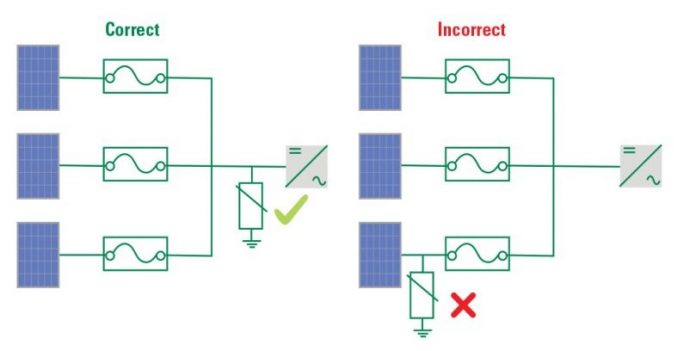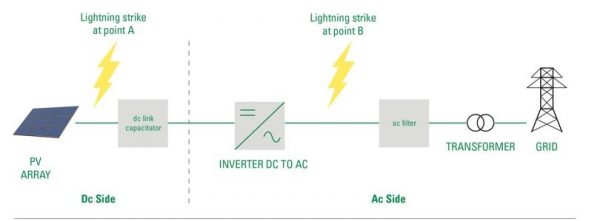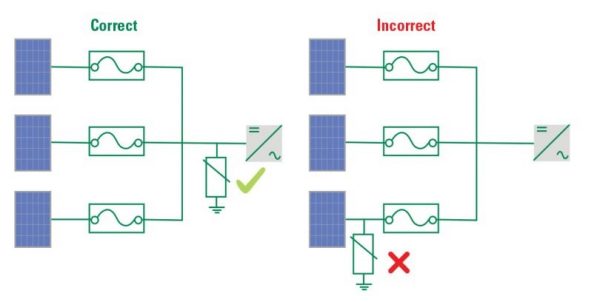Lightning’s perfect storm for destruction is on the solar field. Solar panels’ large—and often exposed and isolated—location make surge protection critical for it to last its lifespan. Photovoltaic Systems are exposed in large open spaces, typically in fields or on the tops of buildings. Charged rain clouds that accumulate over such open fields have the propensity to release the charge in the form of lightning. When this happens, a voltage surge is likely to occur. The more expansive the field is, the more likely destruction is to occur.
Lightning is an electrical discharge in the atmosphere. When lightning strikes, fires are prone to happen due to the release of energy. Nimbus clouds (rain clouds) have a concentration of electrical charge, and their accumulation creates an ionization of air. The ionization of air that is between the ground and the nimbus clouds creates a discharge from the clouds to the ground. Nimbus clouds cause the biggest surges because they are what generate lightning.
Indirect lightning strikes are destructive. Anecdotal observations about lightning activity is usually a poor indicator of the level of lightning-induced over voltages in PV arrays. Indirect lightning strikes can easily damage the sensitive components within PV equipment, which often has a high cost to repair or replace the damaged components and affects the PV system’s reliability. The overvoltage depends on the setup conditions of each PV system and the wirings.
Electronic equipment can easily be damaged to the point of catastrophic failure by surges. If a surge occurs when any personnel are present, it will jeopardize their safety as well. Indirect lightning strikes can be fatal if the person is within 60 feet from the point of the lightning strike. When a PV system is located on an industrial site, the business operations and equipment are also at jeopardy. Inverters are expensive, but for industrial applications, an even more expensive failure is the cost of downtime.
When lightning strikes a solar PV system, it causes an induced transient current and voltage within the solar PV system wire loops. These transient currents and voltages will appear at the equipment terminals and likely cause insulation and dielectric failures within the solar PV electrical and electronics components such as the PV panels, the inverter, control and communications equipment, as well as devices in the building installation. The array box, the inverter, and the MPPT (maximum power point tracker) device have the highest points of failure.
To prevent high energy from passing through electronics and causing high voltage damage to the PV system, voltage surges must have a path to ground. To do this, all conductive surfaces should be directly grounded and all wiring that enters and exits the system (such as Ethernet cables and ac mains) be coupled to ground through surge protection device (SPD).
A SPD is needed for each group of the strings within the array box, the recombiner box, as well as the dc disconnect.
Surge protection device classifications
SPDs provide protection against the hazards caused by surges.
UL 1449 [4] defines type 1, type 2, and type 3 SPDs:
- Type 1:One port, permanently connected SPDs, except for watt-hour meter socket enclosures, intended for installation between the secondary of the service transformer and the line side of the service equipment overcurrent device, as well as the load side, including watt-hour meter socket enclosures and molded case SPDs intended to be installed without an external overcurrent protective device. Type 1 SPDs for use in PV systems can be connected between the PV array and the main service disconnect.
- Type 2:Permanently connected SPDs intended for installation on the load side of the service equipment overcurrent device; including SPDs located at the branch panel and molded case SPDs. The Imax value is the maximum single discharge current represented by an 8/20 µs waveform that the SPD can support.
- Type 3:Point of utilization SPDs, installed at a minimum conductor length of 10 meters from the electrical service panel to the point of utilization, for example cord connected, direct plug-in, receptacle type and SPDs installed at the utilization equipment being protected. The distance (10 meters) is exclusive of conductors that are provided with or used to attach SPDs.
Type 1 SPDs protect against direct lightning strikes and are characterized by 10/350 µs current wave. Type 1 SPDs are used in central inverters.
Type 2 SPDs protect against indirect lightning strikes, which are characterized by 8/20 µs waveforms. An 8/20 µs waveform means that the strike has an 8 µs rise time and a duration to one-half peak of 20 µs. Type 2 SPDs prevent the spread of overvoltage into electrical installations and equipment. They also protect against lightning’s electromagnetic effect that propagates a surge within the wire.
A type 2 SPD should be used on each MPPT and within string inverters and array boxes.
The boxes where surges occur are usually damaged from strikes that are indirect. It is not only the type of material and height, but also the shape that affects an object’s ability to attract lightning strikes. If the shape of the box or the material has a propensity to attract lightning strikes, then a type 1 SPD or a lightning rod should be used.
Height, pointed shapes, and isolation are the dominant characteristics that determine where lightning strikes. It is a myth that metal attracts lightning. However, it is important to note that no matter where the PV farm is located, or the shape of any nearby objects, SPDs are essential for every Photovoltaic system due to their inherent susceptibility to direct and indirect strikes.
Surge Protection Device Selection and Installation for Photovoltaic Systems
PV systems have unique characteristics, which therefore require the use of SPDs that are specifically designed for PV systems.
PV systems have high dc system voltages up to 1500 volts. Their maximum power point operates at only a few percentiles below the system’s short circuit current.
To determine the proper SPD module for the PV system and its installation, you must know:
- the lightning round flash density;
- the system’s operating temperature;
- the system’s voltage;
- the system’s short circuit current rating;
- the level of waveform that is to be protected against (indirect or direct lightning); and
- the nominal discharge current.
The SPD requirements for an installation that is protected by an external lightning protection system (LPS) depend on the selected class of the LPS and whether the separation distance between the LPS and the PV installation is isolated or non-isolated. IEC 62305-3 details the separation distance requirements for an external LPS.
To have a protective effect, an SPD’s voltage protection level (Up) should be 20 % lower than the dielectric strength of the system’s terminal equipment.
It is important to use an SPD with a short circuit withstand current greater than the short circuit current of the solar array string that the SPD is connected to. The SPD that is provided on the dc output must have a dc MCOV equal to or greater than the maximum photovoltaic system voltage of the panel.
When lightning strikes at point A (see Figure 1), the solar Photovoltaic panel and the inverter are likely to be damaged. Only the inverter will be damaged if the lightning strikes at point B. However, the inverter is typically the most expensive component within a PV system, which is why it is essential to properly select and install the correct SPD on both the ac and dc lines. The closer the strike is to the inverter, the more damaged the inverter will be.
FIGURE 1. Lightning strike location.
SPDS for the DC side of photovoltaic systems
Photovoltaic sources have very different current and voltage characteristics than traditional dc sources: they have a non-linear characteristic and cause long-term persistence of ignited arcs. Therefore, PV current sources not only require larger PV switches and PV fuses, but also a disconnector for the surge protective device which is adapted to this unique nature and capable of coping with Photovoltaic currents.
SPDs installed on the dc side must always be specifically designed for dc applications. The use of an SPD on the incorrect ac or dc side is hazardous under fault conditions.
When SPDs are used on the dc side, they must also be used on the ac side due to the potential differences.
SPDS for the AC side
Surge protection is just as important for the ac side as it is for the dc side. Ensure that the SPD is specifically designed for the ac side.
For optimal protection, the SPD should be sized specifically for the system. The proper selection will guarantee the best protection with the longest lifespan.
On the ac side, multiple inverters can be connected to the same SPD if they share the same grid connection.
Installation
SPDs should always be installed upstream of the devices they are going to protect. NFPA 780 12.4.2.1 says that surge protection shall be provided on the dc output of the solar panel from positive to ground and negative to ground, at the combiner and recombiner box for multiple solar panels, and at the ac output of the inverter.
- The proper installation of an SPD relies on three values, which are:
- Maximum continuous operating voltage: The voltage that the SPD will activate.
- Voltage protection level: The equipment’s overvoltage category must be higher than the SPD’s voltage protection level.
- Nominal discharge current: The peak value of waveform (8/20 µs for type 2 SPDs) that the SPD is capable of withstanding after repetitive surges.
Cables
The cables in PV systems are often extended across long distances so that they can reach the grid connection point. However, long cable lengths are never recommended, and PV systems are far from an exception.
This is because the effect of field-based and conducted electrical interference that is caused by lightning discharges increases in relation with increasing cable lengths and conductor loops. When a transient overvoltage occurs, any inductive voltage drop in the connecting cables can weaken the SPD’s protective effect. This is less likely to happen if the cables are routed to be as short as possible.
Surge voltage is a significant contributor to cable failure, and each impulse on a cable will contribute to the deterioration of the cable’s insulation strength.
If a surge is injected into a stand-alone Photovoltaic system (a system that is far from the power grid), any equipment operations that are powered by solar electricity, such as medical equipment or water supply, may be disrupted.
The location and quantity of SPDs to install on the dc side depend on the length of cable between the solar panels and the inverter (see Table 1). If the length is less than 10 meters, then only one SPD is necessary and the SPD should be installed within the same vicinity as the inverter. If the length of the cable is more than 10 meters, then install one SPD within the vicinity of the inverter as well as a second SPD in the box that is close to the solar panel.
Route cables in such a way that avoids large conductor loops. Ac and dc lines and data lines must be routed together with the equipotential bonding conductors along the entire route to ensure that conductor loops are not formed from being routed over several strings or when connecting the inverter to the grid connection.
TABLE 1. SPD selection.
How to combine SPDS with inverters
PV farms are comprised of very sensitive equipment that needs expansive protection. Because Photovoltaic farms create direct current (dc) power, inverters (which are necessary to convert this power from dc to ac) are an essential component to their electrical production. Unfortunately, inverters are not only highly susceptible to lightning strikes but they are incredibly expensive.
NFPA 780, Standard for the Installation of Lightning Protection Systems, in 12.4.2.3 requires additional SPDs at the dc input of the inverter if the system inverter is more than 30 meters from the closest combiner or recombiner box.
Install the SPD between the fuses and the inverter if there are string protectors (such as fuses, dc breakers or string diodes) [see Figure 2].
FIGURE 2. SPD correctly and incorrectly connected to inverter with string protectors.
To connect an SPD when there is an inverter with an integrated fuse box, ensure that the internal fuses are bypassed and that the external string fuses are connected (see Figure 3). The SPDs must be mounted outside of the inverter and in a NEMA Type- 3R enclosure or higher if it is an outdoor application.
String inverters should be installed as close to the strings as possible. SPD cables that connect to the L+/L- network, and between the SPD’s terminal block and ground busbar, must be less than 2.5 meters. The shorter the connection cables, the more efficient and cost-effective the protection will be.
For inverters with only one MPP tracker, combine the string before the inverter and connect them to the SPD at the point of interconnection.
SPD combinations should be planned for each input when the inverter has multiple MPP trackers. An SPD must be used for each input that is fused with a string diode.
FIGURE 3. SPD connected to inverter with integrated fuse box
Conclusion
To operate photovoltaic equipment without proper surge protection is more than risky business—it is reckless.
For solar systems to be the future of a greener world, they must be protected. The occurrence of lightning is unstoppable and thus, protection is essential.
Photovoltaic systems’ vulnerability to lightning strikes—both direct and indirect—means that they must be built with reliable and properly installed surge protection.












